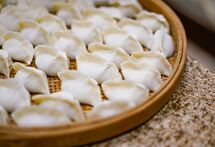这些过年传统美食 让你越吃越好运
|
中国人过春节,讲究的是亲朋好友团聚,享用传统美食。你知道过年为什么要吃饺子和春卷吗?为什么过年吃白菜萝卜馅饺子比吃酸菜馅饺子吉利? 究竟如何吃出一个喜庆繁荣的好运年呢?今天我们就来揭示这些吉利食物的寓意。
Chinese Dumplings — Wealth With a history of more than 1,800 years, dumplings are a classic Chinese food, and a traditional dish eaten on Chinese New Year's Eve, widely popular in China, especially in North China. Chinese dumplings can be made to look like Chinese silver ingots (which are not bars, but boat-shaped, oval, and turned up at the two ends). Legend has it that the more dumplings you eat during the New Year celebrations, the more money you can make in the New Year. Dumplings generally consist of minced meat and finely-chopped vegetables wrapped in a thin and elastic dough skin. Popular fillings are minced pork, diced shrimp, fish, ground chicken, beef, and vegetables. They can be cooked by boiling, steaming, frying or baking. Chinese don't eat Chinese sauerkraut dumplings at Spring Festival, because it implies a poor and difficult future. On New Year's Eve it is a tradition to eat dumplings with cabbage and radish, implying that one's skin will become fair and one's mood will become gentle.
When making dumplings there should be a good number of pleats. If you make the junction too flat, it is thought to purport poverty. Some Chinese put a white thread inside a dumpling, and the one who eats that dumpling is supposed to possess longevity. Sometimes a copper coin is put in a dumpling, and the one who eats it is supposed to become wealthy. Dumplings should be arranged in lines instead of circles, because circles of dumplings are supposed to mean one's life will go round in circles, never going anywhere. Fish — an Increase in Prosperity In Chinese, "fish" (鱼 Yú /yoo/) sounds like 'surplus'. Chinese people always like to have a surplus at the end of the year, because they think if they have managed to save something at the end of the year, then they can make more in the next year.
What fish should be chosen for the New Year feast is based on auspicious homophonics. Crucian carp: As the first character of ‘crucian carp' (鲫鱼 jìyú /jee-yoo/) sounds like the Chinese word 吉 (jí /jee/ ‘good luck'), eating crucian carp is considered to bring good luck for the next year. Chinese mud carp: The first part of the Chinese for “mud carp” (鲤鱼 lǐyú /lee-yoo/) is pronounced like the word for gifts (礼 lǐ /lee/). So Chinese people think eating mud carp during the Chinese New Year symbolizes wishing for good fortune. Catfish: The Chinese for “catfish” (鲶鱼 niányú /nyen-yoo/) sounds like 年余 (nián yú) meaning ‘year surplus'. So eating catfish is a wish for a surplus in the year. Eating two fish, one on New Year's Eve and one on New Year's Day, (if written in a certain way) sounds like a wish for a surplus year-after-year. If only one catfish is eaten, eating the upper part of the fish on New Year's Eve and the remainder on the first day of the new year can be spoken with the same homophonic meaning.
The fish should be the last dish left with some left over, as this has auspicious homophonics for there being surpluses every year. This is practiced north of the Yangtze River, but in other areas the head and tail of the fish shouldn't be eaten until the beginning of the year, which expresses the hope that the year will start and finish with surplus. There are some rules related to the position of the fish. The head should be placed toward distinguished guests or elders, representing respect. Diners can enjoy the fish only after the one who faces the fish head eats first. The fish shouldn't be moved. The two people who face the head and tail of fish should drink together, as this is considered to have a lucky meaning. Spring Rolls — Wealth Spring rolls get their name because they are traditionally eaten during the Spring Festival. It is a dish especially popular in East China: Jiangxi, Jiangsu, Shanghai, Fujian, Guangzhou, Shenzhen, Hong Kong, etc. Spring rolls are a Cantonese dim sum dish of cylindrical-shaped rolls filled with vegetables, meat, or something sweet. Fillings are wrapped in thin dough wrappers, then fried, when the spring rolls are given their golden-yellow color. Glutinous Rice Cake — a Higher Income or Position In Chinese, glutinous rice cake (年糕 Niángāo /nyen-gaoww/) sounds like it means "'getting higher year-on- by year"'. The main ingredients of niangao are sticky rice, sugar, chestnuts, Chinese dates, and lotus leaves. Sweet Rice Balls — Family Togetherness Sweet rice ball (汤圆 Tāngyuán /tung-ywen/) is the main food for China's Lantern Festival, however, in south China, people eat them throughout the Spring Festival. The pronunciation and round shape of tangyuan are associated with reunion and being together. That’s why they are favored by the Chinese during the New Year celebrations. Good Fortune Fruit — Fullness and Wealth Certain fruits are eaten during the Chinese New Year period, such as tangerines and oranges, and pomeloes. They are selected as they are particularly round and "golden" in color, symbolizing fullness and wealth, but more obviously for the lucky sound they bring when spoken. Eating and displaying tangerines and oranges is believed to bring good luck and fortune due to their pronunciation, and even writing. The Chinese for orange (and tangerine) is 橙 (chéng /chnng/), which sounds the same as the Chinese for 'success' (成). One of the ways of writing tangerine (桔 jú /jyoo/) contains the Chinese character for luck (吉 jí /jee/). It’s good if tangerines have leaves, because leaves symbolize longevity. But don’t group them in fours, because this number is associated with death. Eating pomeloes/shaddocks is thought to bring continuous prosperity. The more you eat, the more wealth it will bring, as the traditional saying goes. The Chinese for pomelo (柚 yòu /yo/) sounds like 'to have' (有 yǒu), except for the tone, and exactly like 'again' (又 yòu). 说到底,不管吃什么,图的都是个吉利,希望2020年大家都招财进宝(饺子)、黄金万两(春卷)、年年高(年糕)! |









